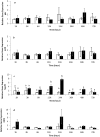Constitutive or Inducible Protective Mechanisms against UV-B Radiation in the Brown Alga Fucus vesiculosus? A Study of Gene Expression and Phlorotannin Content Responses
- PMID: 26030665
- PMCID: PMC4452539
- DOI: 10.1371/journal.pone.0128003
Constitutive or Inducible Protective Mechanisms against UV-B Radiation in the Brown Alga Fucus vesiculosus? A Study of Gene Expression and Phlorotannin Content Responses
Abstract
A role as UV sunscreens has been suggested for phlorotannins, the phenolic compounds that accumulate in brown algae in response to a number of external stimuli and take part in cell wall structure. After exposure of the intertidal brown alga Fucus vesiculosus to artificial UV-B radiation, we examined its physiological responses by following the transcript level of the pksIII gene encoding a phloroglucinol synthase, likely to be involved in the first step of phlorotannins biosynthesis. We also monitored the expression of three targeted genes, encoding a heat shock protein (hsp70), which is involved in global stress responses, an aryl sulfotransferase (ast), which could be involved in the sulfation of phlorotannins, and a vanadium bromoperoxidase (vbpo), which can potentially participate in the scavenging of Reactive Oxygen Species (ROS) and in the cross-linking and condensation of phlorotannins. We investigated whether transcriptional regulation of these genes is correlated with an induction of phlorotannin accumulation by establishing metabolite profiling of purified fractions of low molecular weight phlorotannins. Our findings demonstrated that a high dose of UV-B radiation induced a significant overexpression of hsp70 after 12 and 24 hours following the exposure to the UV-B treatment, compared to control treatment. The physiological performance of algae quantified by the photosynthetic efficiency (Fv/Fm) was slightly reduced. However UV-B treatment did not induce the accumulation of soluble phlorotannins in F. vesiculosus during the kinetics of four weeks, a result that may be related to the lack of induction of the pksIII gene expression. Taken together these results suggest a constitutive accumulation of phlorotannins occurring during the development of F.vesiculosus, rather than inducible processes. Gene expression studies and phlorotannin profiling provide here complementary approaches to global quantifications currently used in studies of phenolic compounds in brown algae.
Conflict of interest statement
Figures





References
-
- Davison IR, Pearson GA (1996) Stress tolerance in intertidal seaweeds. J Phycol 32: 197–211. - PubMed
-
- Baldauf SL (2008) An overview of the phylogeny and diversity of eukaryotes. J Syst Evol 46: 263–273.
-
- Meslet-Cladiere L, Delage L, J.-J. Leroux C, Goulitquer S, Leblanc C, Creis E, et al. (2013) Structure/Function Analysis of a Type III Polyketide Synthase in the Brown Alga Ectocarpus siliculosus Reveals a Biochemical Pathway in Phlorotannin Monomer Biosynthesis. Plant Cell 25: 3089–3103. 10.1105/tpc.113.111336 - DOI - PMC - PubMed
-
- Berglin M, Delage L, Potin P, Vilter H, Elwing H (2004) Enzymatic cross-linking of a phenolic polymer extracted from the marine alga Fucus serratus. Biomacromolecules 5: 2376–2383. - PubMed
-
- Salgado LT, Cinelli LP, Viana NB, Tomazetto de Carvalho R, de Souza Mourão PA, Laneuville Teixeira V, et al. (2009) a Vanadium Bromoperoxidase Catalyzes the Formation of High-Molecular-Weight Complexes Between Brown Algal Phenolic Substances and Alginates. J Phycol 45: 193–202. - PubMed
Publication types
MeSH terms
Substances
LinkOut - more resources
Full Text Sources
Other Literature Sources

